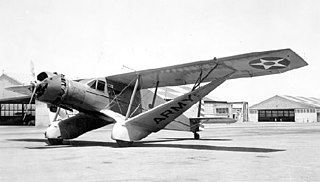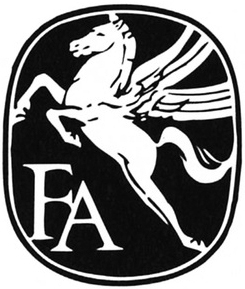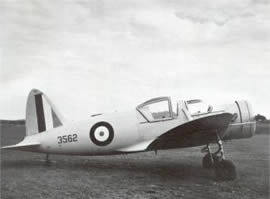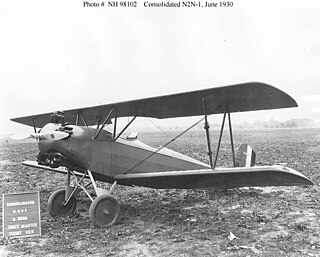
The Fairchild PT-19 is an American monoplane primary trainer aircraft that served with the United States Army Air Forces, RAF and RCAF during World War II. Designed by Fairchild Aircraft, it was a contemporary of the Kaydet biplane trainer, and was used by the USAAF during Primary Flying Training. As with other USAAF trainers of the period, the PT-19 had multiple designations based on the powerplant installed.

The Vickers Viking was a British single-engine amphibious aircraft designed for military use shortly after World War I. Later versions of the aircraft were known as the Vickers Vulture and Vickers Vanellus.

The C-82 Packet is a twin-engine, twin-boom cargo aircraft designed and built by Fairchild Aircraft. It was used briefly by the United States Army Air Forces and the successor United States Air Force following World War II.

The Bellanca Aircruiser and Airbus were high-wing, single-engine aircraft built by Bellanca Aircraft Corporation of New Castle, Delaware. The aircraft was built as a "workhorse" intended for use as a passenger or cargo aircraft. It was available with wheels, floats or skis. The aircraft was powered by either a Wright Cyclone or Pratt and Whitney Hornet engine. The Airbus and Aircruiser served as both commercial and military transports.

The Fleet Finch is a two-seat, tandem training biplane produced by Fleet Aircraft of Fort Erie, Ontario. There were a number of variants mainly based on engine variations. Over several years beginning in 1939, a total of 447 Finches were built, nearly all (431) of them for use as elementary trainers in the British Commonwealth Air Training Plan (BCATP) during the Second World War.

The Bristol Fairchild Bolingbroke is a maritime patrol aircraft and trainer used by the Royal Canadian Air Force during the Second World War. Produced by Fairchild-Canada, it was a license-built version of the Bristol Blenheim Mk IV bomber.

Fairchild Aircraft Ltd. was an aircraft manufacturer active at Longueuil, Quebec, Canada in the period 1920–50. It served as a subsidiary of the Fairchild Aircraft company of the United States.

The Fairchild F-11 Husky was a Canadian bush plane designed and manufactured in the post-Second World War era. Despite a promising design, a lack of a suitable powerplant hurt performance, and stiff competition from the de Havilland Beaver and de Havilland Otter designs meant the type never gained a solid foothold in the marketplace.

The Fleet Model 60K Fort was the only aircraft designed and built by Canadians during the Second World War and was also the first all-metal monoplane built by Fleet Aircraft of Canada. It was intended to be an intermediate trainer employed for pilot training between the de Havilland Tiger Moth primary trainer and the North American Harvard advanced trainer. Although it served with the British Commonwealth Air Training Plan, the Fort was redundant and was used to train wireless (radio) operators and had a relatively short operational career.

The Albatros L 82 was a 1920s German trainer biplane. Of conventional configuration, it seated the pilot and instructor in separate, open cockpits. The wings were single-bay, equal-span, and unstaggered.

The Maple Leaf Trainer II was a Canadian biplane trainer designed by Elsie MacGill in 1938 and manufactured by the Canadian Car and Foundry. Although it was intended for use as a basic trainer for the Royal Canadian Air Force, it was rejected and the only completed airframe was sold to Mexico, the remaining nine aircraft were later built there.

The Bellanca CH-300 Pacemaker was a six-seat utility aircraft, built primarily in the United States in the 1920s and 1930s. It was a development of the Bellanca CH-200, fitted with a more powerful engine and, like the CH-200, soon became renowned for its long-distance endurance.

The Bellanca 31-40 Senior Pacemaker and its derivatives were a family of a six- and eight-seat utility aircraft built in the United States in the late 1930s. They were the final revision of the original late 1920s Wright-Bellanca WB-2 design. The model numbers used by Bellanca in this period reflected the wing area and engine horsepower, each divided by ten. Like their predecessors, these were high-wing braced monoplanes with conventional tailwheel undercarriage.

The Fleet Model 1 and its derivatives were a family of two-seat trainer and sports biplanes produced in the United States and Canada in the 1920s and 1930s. They all shared the same basic design and varied mainly in their powerplants.

The Fairchild 71 was an American high-wing monoplane passenger and cargo aircraft built by Fairchild Aircraft and later built in Canada by Fairchild Aircraft Ltd. (Canada) for both military and civilian use as a rugged bush plane.

The Fairchild FC-1 and its derivatives were a family of light, single-engine, high-wing utility monoplanes produced in the United States in the 1920s and 1930s. The aircraft was originally designed to provide a camera platform for Sherman Fairchild's aerial photography and survey business, Fairchild Aerial Surveys.

The Fairchild Super 71 was a Canadian parasol-mounted high-wing monoplane cargo aircraft built by Fairchild Aircraft Ltd. (Canada). The Super 71 was an entirely new design that was one of the first purpose-built civilian bush planes for use in remote and northern locales in Canada.

The Fairchild 45-80 Sekani was a Canadian twin-engined transport aircraft developed in Canada in the late 1930s. Although the 45-80 was the largest bush plane developed by Fairchild, its poor performance doomed the project, and nearly the company.

The Bellanca CE was the first aircraft designed for the Maryland Pressed Steel Company, by the aircraft designer Giuseppe Mario Bellanca. The aircraft was also called the Bellanca C.E. or the "CE Tractor Biplane".

The Hubbard Monoplane, also nicknamed "Mike", was an early aircraft designed by John McCurdy and built by the Canadian Aerodrome Company.

























